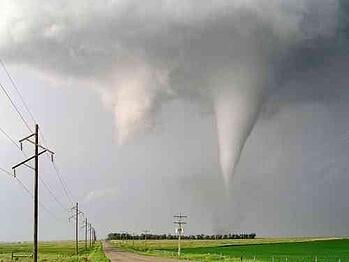Utility Poles and Tornadoes: Joint Use Preparation and Recovery
 With wind speeds of up to 300 miles per hour, widths that reach more than one mile across and paths of destruction that can exceed 50 miles long, tornadoes are arguably the most violent storms that occur in nature.1 Capable of toppling trees, leveling houses and tossing cars dozens of feet up in the air, it should be no surprise that tornadoes can cause severe damage to utility poles and power lines: power lines and transformers can be downed and poles can be completely pulled from the ground and sent flying, leaving thousands without power in the blink of an eye.
With wind speeds of up to 300 miles per hour, widths that reach more than one mile across and paths of destruction that can exceed 50 miles long, tornadoes are arguably the most violent storms that occur in nature.1 Capable of toppling trees, leveling houses and tossing cars dozens of feet up in the air, it should be no surprise that tornadoes can cause severe damage to utility poles and power lines: power lines and transformers can be downed and poles can be completely pulled from the ground and sent flying, leaving thousands without power in the blink of an eye.
As with any other destructive weather system, there is little that can be done to avoid the potential damage tornadoes cause, however there is much that can be done to be properly prepared to restore poles, and power, in a quick and efficient manner.
Accurate Inventory
Maintaining an accurate inventory of joint use utility poles is vital when it comes to replacing poles and attachments — especially in the case when utility poles are not merely downed, but completely gone. An up-to-date record of all company and foreign-owned attachments allows utility pole owners to know, without question, what poles need to be replaced and what equipment needs to be attached.
Digital Records
Tornadoes do not only destroy power lines and utility poles, but they can also wipe out office buildings, including a utility company’s headquarters. This underscores the importance of having digital records for everything from utility pole inventory to joint use partner contracts. If a company solely relies on paper-based records, a tornado can easily destroy those records, and with them, the company. The Paperless Project, a grassroots coalition that concentrates on reducing companies’ paper usage and increasing their electronic content claims that “more than 70% of today’s businesses would fail within three weeks if they suffered a catastrophic loss of paper-based records.”2 Not only do digital asset records ensure that your important data and contracts are stored safely, but they also allow important information to be shared and accessed easily. For instance, utility workers can readily access information regarding utility poles when working to restore power after a tornado or other type of storm.
Customer Communication
In June of 2013 massive tornadoes tore through the state of Oklahoma and took down more than 560 utility poles, more than 620 cross arms and approximately 160 transformers, leaving hundreds of thousands without power.3 OGE Energy Corp., an energy supplying and trading company that services Oklahoma and Arkansas not only took to social media to provide updates regarding outages and restoration times, but also created an online map that highlighted specific areas to show their estimated time of power restoration.4 By being proactive, their customers were able to access up-to-date information directly from the company on when power was to be restored.
It is. without any doubt. a complicated matter to replace utility poles and restring power lines following a tornado, but with accurate data and digital records, the process can be made simpler and more efficient. Providing updates to customers can also help to put the public more at ease and allow companies to focus on restoring power to the community, rather than fielding customer complaints.
[1] http://www.ready.gov/tornadoes
[2] http://www.thepaperlessproject.com/what-are-the-facts-about-paper/
[3] http://www.elp.com/articles/print/volume-91/issue-4/features/industry-report/customers-speak-up.html
[4] http://kfor.com/2013/06/04/power-almost-fully-restored-after-tornadoes-flooding/
